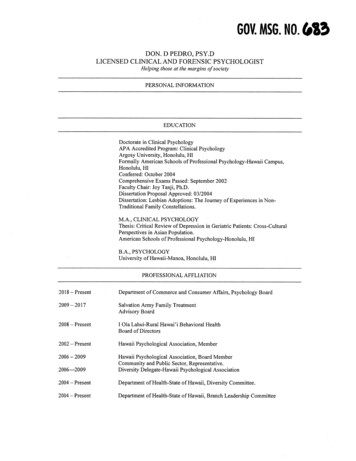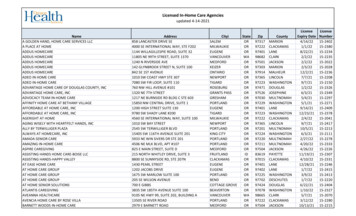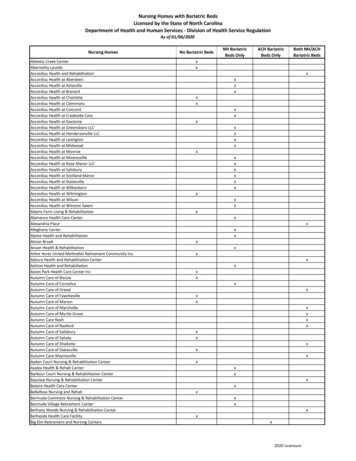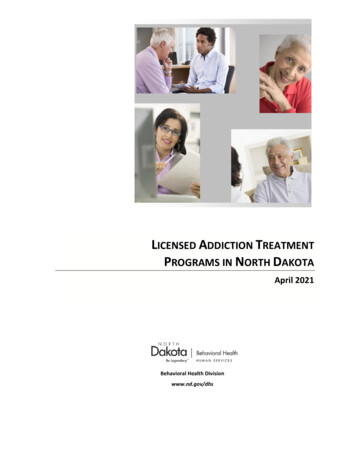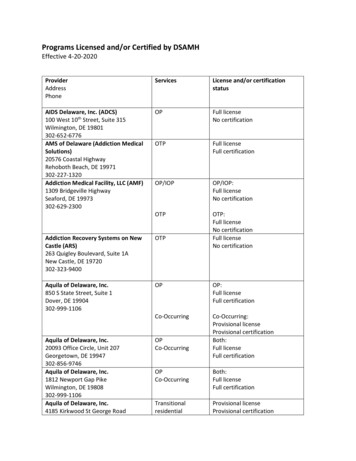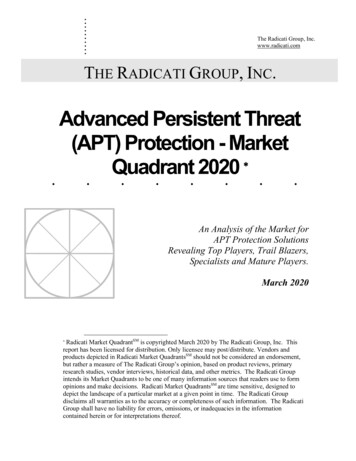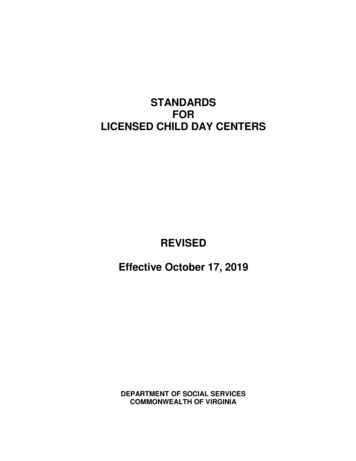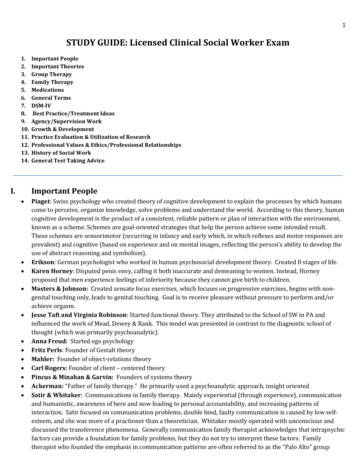
Transcription
1STUDY GUIDE: Licensed Clinical Social Worker Exam1.2.3.4.5.6.7.8.9.10.11.12.13.14.I.Important PeopleImportant TheoriesGroup TherapyFamily TherapyMedicationsGeneral TermsDSM-IVBest Practice/Treatment IdeasAgency/Supervision WorkGrowth & DevelopmentPractice Evaluation & Utilization of ResearchProfessional Values & Ethics/Professional RelationshipsHistory of Social WorkGeneral Test Taking AdviceImportant People Piaget: Swiss psychology who created theory of cognitive development to explain the processes by which humanscome to perceive, organize knowledge, solve problems and understand the world. According to this theory, humancognitive development is the product of a consistent, reliable pattern or plan of interaction with the environment,known as a scheme. Schemes are goal-oriented strategies that help the person achieve some intended result.These schemes are sensorimotor (occurring in infancy and early which, in which reflexes and motor responses areprevalent) and cognitive (based on experience and on mental images, reflecting the person’s ability to develop theuse of abstract reasoning and symbolism).Erikson: German psychologist who worked in human psychosocial development theory. Created 8 stages of life.Karen Horney: Disputed penis envy, calling it both inaccurate and demeaning to women. Instead, Horneyproposed that men experience feelings of inferiority because they cannot give birth to children.Masters & Johnson: Created sensate focus exercises, which focuses on progressive exercises, begins with nongenital touching only, leads to genital touching. Goal is to receive pleasure without pressure to perform and/orachieve orgasm.Jesse Taft and Virginia Robinson: Started functional theory. They attributed to the School of SW in PA andinfluenced the work of Mead, Dewey & Rank. This model was presented in contrast to the diagnostic school ofthought (which was primarily psychoanalytic).Anna Freud: Started ego psychologyFritz Perls: Founder of Gestalt theoryMahler: Founder of object-relations theoryCarl Rogers: Founder of client – centered theoryPincus & Minahan & Garvin: Founders of systems theoryAckerman: “Father of family therapy.” He primarily used a psychoanalytic approach, insight orientedSatir & Whitaker: Communications in family therapy. Mainly experiential (through experience), communicationand humanistic, awareness of here and now leading to personal accountability, and increasing patterns ofinteraction. Satir focused on communication problems, double bind, faulty communication is caused by low selfesteem, and she was more of a practioner than a theoretician. Whitaker mostly operated with unconscious anddiscussed the transference phenomena. Generally communication family therapist acknowledges that intrapsychicfactors can provide a foundation for family problems, but they do not try to interpret these factors. Familytherapist who founded the emphasis in communication patterns are often referred to as the “Palo Alto” group
2 coming from CA. Strong emphasis on communication theory states that it is impossible to not communicate. Hereemphasis is placed on behavior as communication and the communication inconsistencies that can occur.Bowen: Worked with extended family systems, where rational processes are applied to better understandrelationships (current and intergenerational) and to maximize self-differentiation. Discussed triangulation and thedysfunction can come through several generations. Here the therapist is a coach. Remember, often used in thisapproach are genograms and ecomaps. Psychodynamic family therapy: resolution of problems should includeintrapsychic exploration & resolution of unconscious object-relationships internalized from early parent-childrelationships.Minuchin: Structural family therapy where behaviors are established through changes in transactional patterns,rather than through insight (action comes before insight). Treatment seeks to restructure family unit maladaptivetransactional patterns. He believed if you “improve process” that you improve the family. Techniques often usedin this model include: direct confrontation of family behaviors and prescribing the symptom. This model of familytherapy is considered best for deriving specific outcomes.Haley: Strategic family therapy primarily utilizes communication theory, systems theory and behaviorism. Similarto structural, the emphasis is placed on action rather than insight. Here the therapist often joins the family and isactive in forcing the family to respond differently to situations based on the presence of the therapist and makinguse of family symptoms to bring about change.Liberman: Focused on behavior family therapy & social learning theory. Treatment is focused on changingbehavior patterns. Here the traditions of behavior modification remain where behavior is maintained byconsequences.Albert Bandura: Focus on motivational needs, drives and impulses and cognitions toward action or change – arenot enough. We are social creatures and therefore must take into account social environment - Social Learningtheory.Pavlov: Classical model of conditions: relationship between a stimulus and a response is unlearned or prewired,emphasis on antecedents. (drooling dog)Skinner: Operant model of conditions: learning and reinforcement, emphasis on consequences. (Rat & treatlever)2. Important Theories Psychodynamic Theory: (Little or no free will). The assumption that unconscious cause lies behind every mentalprocess is known as: primary process thinking, secondary process thinking, psychic determinism, consensualvalidation. Psychodynamic theory is predicated on the assumption that there is an unconscious which informsone’s life. Psychic determinism – the idea that personality and behavior are determined more by psychologicalfactors than by biological conditions or current life effects.o ID – The only component of personality that is around from birth. Entirely unconscious and includesinstinctive & primitive behaviors. Source of all psychic energy, the primary component of personality.Strives for the immediate gratification of desires.o Ego – responsible for dealing with reality. Ensures that impulses can be expressed in a manner acceptablein the real world. Functions in the conscious, preconscious & unconscious mind. Based on the realityprinciple - strives to satisfy the id’s desires realistically & appropriately.o Superego – is our sense of right & wrong. Provides guidelines for making judgment. Emerges around age5. Guilt is here. Two parts of the superego The ego ideal: includes the rules & standards for good behaviors. These behaviors includethose which are approved of by parental & other authority figures. The conscience: includes info about things that are viewed as bad by parents and society.These behaviors are usually forbidden & lead to bad consequences.
3ooo Ego strength – the ego’s ability to function, despite dueling forces.Psychosocial development Oral stage: birth – 1 year. Most of the world is interacted with by the mouth. Issues can occurduring weaning. Anal stage: 1-3 years old. Primary focus is controlling the bladder & bowel movements. Accordingto Freud, inappropriate parental responses can result in negative outcomes. If parents take anapproach that is too lenient, Freud suggested that an anal-expulsive personality could develop inwhich the individual has a messy, wasteful or destructive personality. If parents are too strict orbegin toilet training too early, Freud believed that an anal-retentive personality develops in whichthe individual is stringent, orderly, rigid and obsessive. Phallic Stage: 3-6 years old. Child starts to discover the differences between male & females.Freud also believed that boys begin to view their fathers as a rival for the mother’s affections. TheOedipus complex describes these feelings of wanting to possess the mother and the desire toreplace the father. However, the child also fears that he will be punished by the father for thesefeelings, a fear Freud termed castration anxiety. The term Electra complex has been used todescribe a similar set of feelings experienced by young girls. Freud, however, believed that girlsinstead experience penis envy. Eventually, the child begins to identify with the same-sex parent asa means of vicariously possessing the other parent. For girls, however, Freud believed that penisenvy was never fully resolved and that all women remain somewhat fixated on this stage. Latent period: 6-12, the latent period is a time of exploration in which the sexual energy is stillpresent, but it is directed into other areas such as intellectual pursuits and social interactions. Thisstage is important in the development of social and communication skills and self-confidence. Genital: 12 source of satisfaction: Genitals. Outcome – sexuality become focused in mature,genital love and adult satisfaction.Primary process thinking: is the language of the unconscious (e.g. slips of tongue, dreams, associations,jokes and child’s language and thought.Ego Psychology (psychodynamic theory):o Credited to the work of Ana Freud, Erikson and others
4Anna Freud’s focus was on the healthy individual – not the sick one. From this perspective basic drives areinfluenced by the environment and critical periods.o This model draws heavily from psychoanalysis and utilizes the effect of the conscious and unconsciouso Based on scientific determinism: individuals are products of the past, understanding the past explains thepresent (you are determined by your past)o Ego psychology applied to practice: the individual adapts to the environmental context through: Suggestion: the therapist plants a seed or idea Abreaction – in therapeutic context, strong emotions are discussed in regard to the issue andcatharsis (i.e., the release of tension in a protected setting) is achieved. Manipulation – therapist directly or indirectly influences the client to a plan of action. Clarification and interpretation: the therapist pinpoints significant themes, etc. Patterns and/ortrends of thinking are highlighted. In interpretation you make inferences based on what thetherapist hears and believes to be the situation.o Psychosocially oriented concepts that built on Freudian theory but emphasize the individual’s adultdevelopment and ability to solve problems & deal with social realities.Gestalt therapies – German for the world “whole.” Emphasize the current experiences of the client in the hereand now. Patient learns to recognize their needs and how the drive to satisfy those needs may influence theirbehavior. Gestalt theory argues that behavior is more than the sum of its parts.o Founder is Fritz Perls: and the only real time is the present, individual must take responsibility for allaspects of his/her life.o Whole is greater and different from the sum of the parts.o Focus is on the here and now with immediate awareness of personal experienceso In gestalt therapy, unexpressed guilt is viewed as “unfinished business” and the client needs to re-addressthis (i.e., can use empty chair, psychodrama).o Techniques or games often used include: Psychodrama Skillful frustration Dream work empty chairo Rules of Gestalt theory include: Directed awareness – speak in the present tense only, uses directed awareness Use of “I” language – accept responsibility for self and own actions Restricting and planning the use of questions. Avoiding “why” questions because they tend torefocus attention to others and away from the self.Object relations Theory ( a human growth and development theory)o This is more of a psycho-social/human development approach introduced by Mahler and Associates.o According to Mahler, a child must separate and individuate so that he/she can move from being a part ofthe other/child unit to being a member of a family.o Separation occurs when a child differentiates or disengages from the mother.o The child often uses transitional objects such as a teddy bear to separate from the mother.o Individuation occurs when the child develops an inner representation of the mother, ability to test reality, asense of time and an awareness of the existence of other individuals as separate and different fromhim/her. Rapprochement (have to know where it is, but doesn’t have to have it with you anymore) is thelast phase prior to the completion of individuation.Client-Centered Theory (a human relations theory)o Carl Rogers is noted as the foundero This model lack authoritative rigidity and dogma. Most of its premises were made ex post facto.o
5It is based on relationship therapy and the functional school of social casework.Basic goal of therapy is to “release an already existing capacity for self-actualization in a potentiallycompetent individual”o On a person-environment continuum, this model is closest to the persono Techniques used are often considered non-directive (passive, nonjudgmental listening), reflective (activelistening); however, the therapist is seen as an active listener and reinterprets statements made by theclient.Developmental stages – middle latency, late latency, early latency, the phallic stage: 3. early latency (ages 6-8) isa time when the child is cognitively able to separate fact from fantasy and is able to work logically andsystematically on different tasks (Piaget). The child is yet unable to consider alternative ways of thinking or doing,thus she clings to what she “knows” something. I.e., something is black or white, all or nothing. The world isexperienced an understood in terms of absolutes.Reparative Therapy – form of therapy that starts with the assumption that all people are born heterosexual andthe purpose is to cure or convert homosexuals to heterosexuals.Functional Theory: (a problem solving focus with free will)o Two pioneers of this theory were Jesse Taft and Virginia Robinson. Attributed to the School of SW in PAand influenced the work of Mead, Dewey & Rank. This model was prese
STUDY GUIDE: Licensed Clinical Social Worker Exam . 1. Important People 2. Important Theories 3. Group Therapy 4. Family Therapy 5. Medications 6. General Terms 7. DSM-IV 8. Best Practice/Treatment Ideas 9. Agency/Supervision Work 10. Growth & Development 11. Practice Evaluation & Utilization of Research 12. Professional Values & Ethics/Professional Relationships
